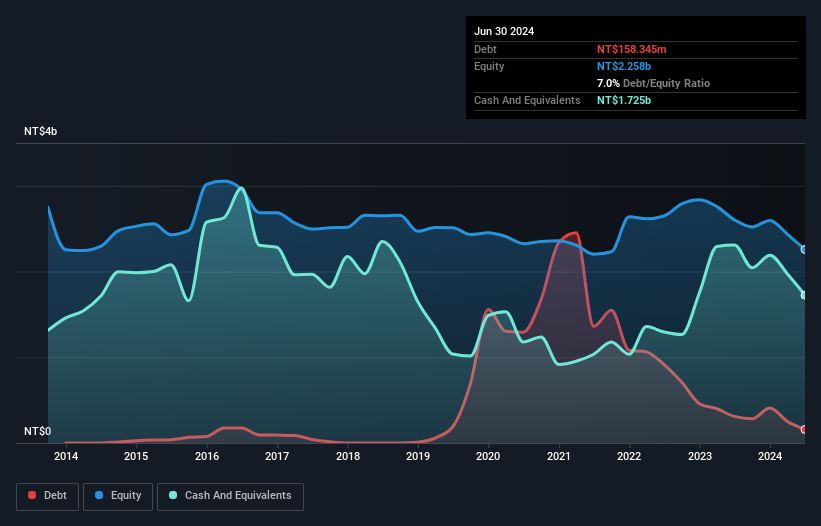
Howard Marks put it nicely when he said that, rather than worrying about share price volatility, 'The possibility of permanent loss is the risk I worry about... and every practical investor I know worries about.' When we think about how risky a company is, we always like to look at its use of debt, since debt overload can lead to ruin. Importantly, Spirox Corporation (TWSE:3055) does carry debt. But is this debt a concern to shareholders?
When Is Debt A Problem?
Debt and other liabilities become risky for a business when it cannot easily fulfill those obligations, either with free cash flow or by raising capital at an attractive price. Part and parcel of capitalism is the process of 'creative destruction' where failed businesses are mercilessly liquidated by their bankers. However, a more common (but still painful) scenario is that it has to raise new equity capital at a low price, thus permanently diluting shareholders. By replacing dilution, though, debt can be an extremely good tool for businesses that need capital to invest in growth at high rates of return. The first thing to do when considering how much debt a business uses is to look at its cash and debt together.
See our latest analysis for Spirox
What Is Spirox's Net Debt?
You can click the graphic below for the historical numbers, but it shows that Spirox had NT$158.3m of debt in June 2024, down from NT$310.1m, one year before. But it also has NT$1.73b in cash to offset that, meaning it has NT$1.57b net cash.

How Strong Is Spirox's Balance Sheet?
We can see from the most recent balance sheet that Spirox had liabilities of NT$568.5m falling due within a year, and liabilities of NT$174.8m due beyond that. On the other hand, it had cash of NT$1.73b and NT$266.7m worth of receivables due within a year. So it actually has NT$1.25b more liquid assets than total liabilities.
It's good to see that Spirox has plenty of liquidity on its balance sheet, suggesting conservative management of liabilities. Given it has easily adequate short term liquidity, we don't think it will have any issues with its lenders. Succinctly put, Spirox boasts net cash, so it's fair to say it does not have a heavy debt load! The balance sheet is clearly the area to focus on when you are analysing debt. But it is future earnings, more than anything, that will determine Spirox's ability to maintain a healthy balance sheet going forward. So if you want to see what the professionals think, you might find this free report on analyst profit forecasts to be interesting.
In the last year Spirox had a loss before interest and tax, and actually shrunk its revenue by 41%, to NT$1.0b. That makes us nervous, to say the least.
So How Risky Is Spirox?
We have no doubt that loss making companies are, in general, riskier than profitable ones. And the fact is that over the last twelve months Spirox lost money at the earnings before interest and tax (EBIT) line. Indeed, in that time it burnt through NT$149m of cash and made a loss of NT$226m. While this does make the company a bit risky, it's important to remember it has net cash of NT$1.57b. That means it could keep spending at its current rate for more than two years. Overall, its balance sheet doesn't seem overly risky, at the moment, but we're always cautious until we see the positive free cash flow. There's no doubt that we learn most about debt from the balance sheet. But ultimately, every company can contain risks that exist outside of the balance sheet. We've identified 1 warning sign with Spirox , and understanding them should be part of your investment process.
Of course, if you're the type of investor who prefers buying stocks without the burden of debt, then don't hesitate to discover our exclusive list of net cash growth stocks, today.
New: Manage All Your Stock Portfolios in One Place
We've created the ultimate portfolio companion for stock investors, and it's free.
• Connect an unlimited number of Portfolios and see your total in one currency
• Be alerted to new Warning Signs or Risks via email or mobile
• Track the Fair Value of your stocks
Have feedback on this article? Concerned about the content? Get in touch with us directly. Alternatively, email editorial-team (at) simplywallst.com.
This article by Simply Wall St is general in nature. We provide commentary based on historical data and analyst forecasts only using an unbiased methodology and our articles are not intended to be financial advice. It does not constitute a recommendation to buy or sell any stock, and does not take account of your objectives, or your financial situation. We aim to bring you long-term focused analysis driven by fundamental data. Note that our analysis may not factor in the latest price-sensitive company announcements or qualitative material. Simply Wall St has no position in any stocks mentioned.
About TWSE:3055
Spirox
Engages in the provision of integrated solutions to the semiconductor and FPD industries in Taiwan, China, and internationally.
Adequate balance sheet minimal.
Market Insights
Community Narratives



